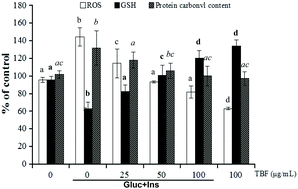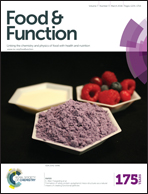Tartary buckwheat flavonoids protect hepatic cells against high glucose-induced oxidative stress and insulin resistance via MAPK signaling pathways
Abstract
Oxidative stress plays a crucial role in chronic complication of diabetes. In this study, the protective effect of purified tartary buckwheat flavonoids (TBF) fraction against oxidative stress induced by a high-glucose challenge, which causes insulin resistance, was investigated on hepatic HepG2 cells. Oxidative status, phosphorylated mitogen-activated protein kinases (MAPKs), nuclear factor E2 related factor 2 (Nrf2) and p-(Ser307)-IRS-1 expression, and glucose uptake were evaluated. Results suggest that treatment of HepG2 cells with TBF alone improved glucose uptake and antioxidant enzymes, and activated Nrf2, and attenuated the IRS-1 Ser307 phosphorylation, and enhanced total levels of IRS-1. Furthermore, the high glucose-induced changes in antioxidant defences, Nrf2, p-MAPKs, p-IRS1 Ser307, and IRS-1 levels, and glucose uptake were also significantly inhibited by pre-treatment with TBF. Interestingly, the selective MAPK inhibitors significantly enhanced the TBF-mediated protection by inducing changes in the redox status, glucose uptake, p-(Ser307) and total IRS-1 levels. This report firstly showed that TBF could recover the redox status of insulin-resistant HepG2 cells, suggesting that TBF significantly protected the cells against high glucose-induced oxidative stress, and these beneficial effects of TBF on redox balance and insulin resistance were mediated by targeting MAPKs.


 Please wait while we load your content...
Please wait while we load your content...